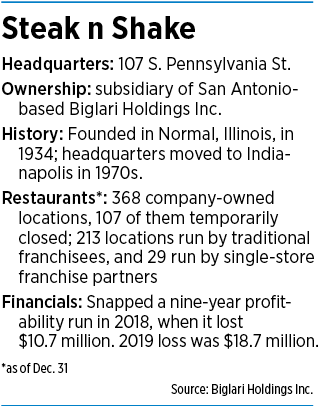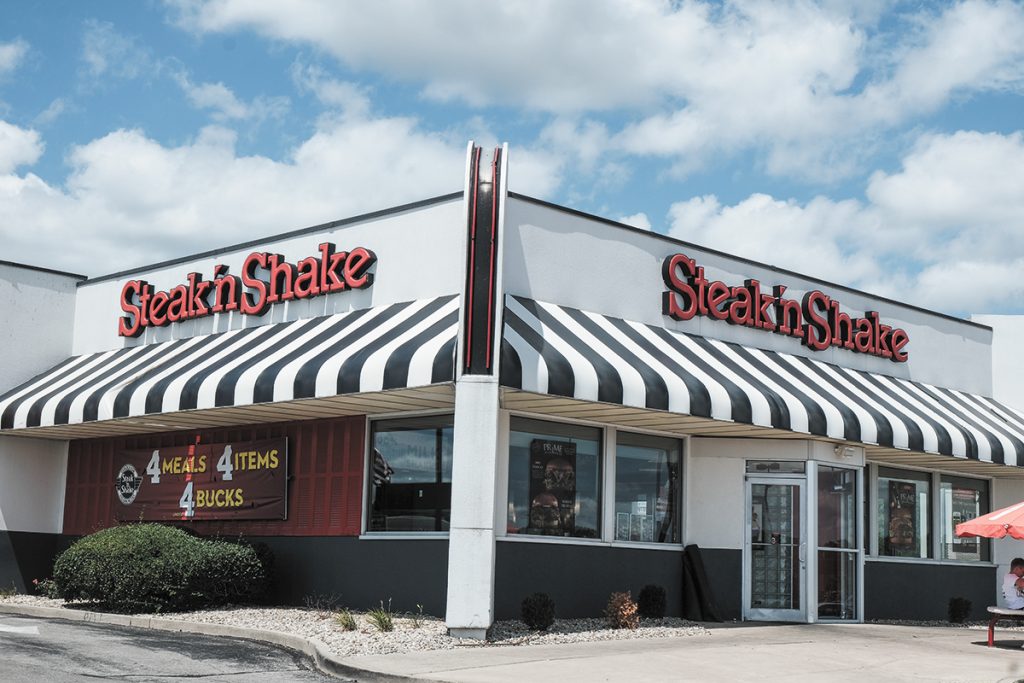Subscriber Benefit
As a subscriber you can listen to articles at work, in the car, or while you work out. Subscribe Now Steak n Shake was on the ropes even before the COVID-19 pandemic hit, with customer traffic counts sliding 22% since 2015 and operating losses over just the last two years totaling $29 million.
Steak n Shake was on the ropes even before the COVID-19 pandemic hit, with customer traffic counts sliding 22% since 2015 and operating losses over just the last two years totaling $29 million.
That would be bad enough, but the company also has a $165 million term loan scheduled to be paid off in March 2021—a debt it lacks the ability to repay and is unlikely to be able to refinance.
Rating agencies, which already ranked Steak n Shake on the lowest rungs of their creditworthiness ladders, further sounded the alarm bells in recent weeks after Steak n Shake paid off some of its debt at a discount—something a lender never would agree to if it thought it was going to be paid in full.


“We view this transaction as tantamount to default because the lender received less value than originally promised,” S&P Global Ratings analysts Declan Gargan and Helena Song said in an April 1 report.
Moody’s Investors Service offered a similarly stern assessment April 21, noting Steak n Shake’s “inability to even partially cover interest expense prior to the impact of COVID-19.”
Added Moody’s analyst Adam McLaren in an April 11 report: “Without a dramatic improvement in operating performance and same-restaurant sales, we view the capital structure as unsustainable.”
Steak n Shake—founded in 1934 in Normal, Illinois, and headquartered in Indianapolis since the 1970s—is part of San Antonio-based Biglari Holdings Inc., led by irrepressible entrepreneur Sardar Biglari.
Publicly traded Biglari Holdings has a broad range of investments—it holds nearly 9% of the Cracker Barrel restaurant chain, for instance, and also owns insurance companies, an operator of oil fields, and the steakhouse franchising firm Western Sizzlin.
But Steak n Shake is on its own in trying to dig out of its debt hole. That’s because Biglari Holdings doesn’t guarantee those obligations. At the parent company’s annual meeting in April 2019, Sardar Biglari said he chose not to do so, forgoing the lower interest rate he would have received if he had.
Biglari, 42, who as a policy does not speak to the press, did not respond to requests for comment.
The chain has 368 company-owned restaurants, though it shuttered 107 last year, saying it intended to reopen them with the oversight of single-store franchisees.
Steak n Shake’s single-store franchisee strategy is a recent creation, and it has 29 restaurants operating under that structure so far. Under that model, the operator doesn’t have to come up with the half-million dollars or more in upfront investment that owners of the chain’s 213 traditionally franchised restaurants do, but he or she must turn over 15% of sales and 50% of profit.
In his annual shareholder letter this February, Biglari backed away from stating that single-store franchisees will take over all the closed locations, though he said he remains committed to expanding that program.
Instead, his new emphasis was on converting them to counter service—an effort to cut into Steak n Shake’s high labor costs, which he said are as much as 8 percentage points above those of competitors.
 The chain wouldn’t have closed restaurants if they were performing well, of course. Analysts say one challenge is that Steak n Shake is saddled with leases on money-losing locations. Refashioning itself into a smaller chain of top-performing restaurants would be difficult to accomplish without filing for bankruptcy and using that legal process to reject leases.
The chain wouldn’t have closed restaurants if they were performing well, of course. Analysts say one challenge is that Steak n Shake is saddled with leases on money-losing locations. Refashioning itself into a smaller chain of top-performing restaurants would be difficult to accomplish without filing for bankruptcy and using that legal process to reject leases.
Steak n Shake didn’t have such deep-seated problems back in 2014, when it secured the term loan—originally for $220 million. Thanks to a deep-discounting strategy Biglari implemented in the teeth of the Great Recession, the chain was riding high, with operating earnings over the prior four years totaling $154 million.
A syndicate of banks anteed up the $220 million, with $119 million going to retire a previous loan. The company held onto $51 million for working capital and other corporate purposes, then sent the remaining $50 million to parent Biglari Holdings as a dividend, according to Securities and Exchange Commission filings.
It’s not clear how steep a discount Steak n Shake was able to reap in the recent deal retiring some of its debt at a discount. Biglari Holdings has not disclosed that information in SEC filings, and rating agencies, which are privy to nonpublic information as part of their debt-rating duties, have not provided details.
However, Moody’s said in a report that the loan balance is now $165 million—$16.5 million less than on Dec. 31, the last date for which the company disclosed financials to the SEC.
Analysts say Steak n Shake might seek to reduce its loan balance further through additional discounted transactions.
Even so, Steak n Shake faces “extreme challenges” in trying to extricate itself from its debt problems, Moody’s analyst William Fahy said in an April 15 report.
S&P said on April 6 that its negative outlook “reflects our view that a conventional default or a restructuring of SnS’s capital structure over the next six months is likely.”
In a report, Fahy said restaurants in Steak n Shake’s niche have been able to retain some of their sales via takeout and drive-thru orders, but sales still are well below normal.
Even restaurants with pristine balance sheets are facing difficult times, of course, as stay-at-home orders and social distancing leave dining rooms empty.
An April 24 S&P report said the spread of COVID-19 is leading restaurants that have issued debt “towards catastrophe.” It said many restaurants will not return to 2019 sales levels until 2022.
But S&P’s Gargan told IBJ that restaurants with stronger financial footing are better able to reposition themselves to meet consumer needs in this challenging environment.
Gargan said that, before the COVID-19 pandemic hit, Steak n Shake already had its hands full trying to “restore its brand strength and relevance.”
He said the coronavirus crisis “really exacerbates those pressures.”•
Please enable JavaScript to view this content.


Short the stock
More like put a bullet in it.